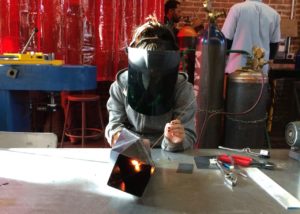Hi SciCheer fans, Samantha here! If you’re in the Bay Area on November 5, 2016, be sure to stop by the Bay Area Science Festival and meet our newest Science Cheerleaders from 10-noon! They’ll be with our partners at SciStarter, to talk about their careers, sign autographs, and get YOU involved in citizen science! Learn more about that appearance, here.

I’ve always had an innate curiosity about the world, but I think elementary school really provided the foundation for my love of math, which guided my path into other STEM areas. In first grade while I was learning my addition and subtraction tables, I caught a glimpse of the second graders’ lessons (they were working on multiplication tables). I remember feeling overcome with the strongest desire to figure out what that cross symbol meant, and luckily convinced my teacher to explain the concept to me. I was hooked! From there, I kept studying, moving on to compete in math competitions in fourth and fifth grade.
By the time I reached high school, I had fallen out of touch with math after moving to a smaller town. However, I was fortunate enough to meet two teachers, Ms. Demianiw and Mr. Mills, who recaptured my attention, helping further my math abilities and introducing me to the world of science, respectively.
What do you do as an engineer?
 As an engineering major in college, I learned how to analyze physical structures to understand both how they worked and how I could make them better. Most of the time, this involved using known forces to calculate how sturdy they were, when and how they would break, and how I could improve them or create entirely new ones. Creating my own products was the fun part – it’s so rewarding to be able to come up with your own idea, create simple prototypes, and then build the final version.
As an engineering major in college, I learned how to analyze physical structures to understand both how they worked and how I could make them better. Most of the time, this involved using known forces to calculate how sturdy they were, when and how they would break, and how I could improve them or create entirely new ones. Creating my own products was the fun part – it’s so rewarding to be able to come up with your own idea, create simple prototypes, and then build the final version.Now I’m learning how to do these same things but in a digital medium (with computer software!).
Why did you try out to be a professional cheerleader?
Ever since high school, cheering provided an outlet for me to work hard and push myself in an area completely unrelated to academics –being able to take a break and switch focus to something new gave my life balance. After graduating from Stanford, I wanted to maintain that balance and help others do the same. I’ve been grateful to discover that cheering professionally provides the opportunity to inspire young girls to shatter stereotypes and pursue their dreams, no matter what they may be.
Best STEM-related experience?
My best STEM-related experience includes the amazing academic support I received in high school. My teachers gave me so many incredible opportunities to pursue interests beyond what the classroom texts offered – through tutoring opportunities, lab work, and more. They pushed me to grow in ways I never thought possible.
What advice would you give your 12-year-old self?
Don’t set limits for yourself. You’re capable of some truly amazing things if you put your mind to it!

